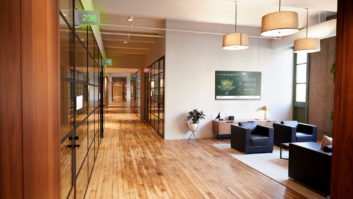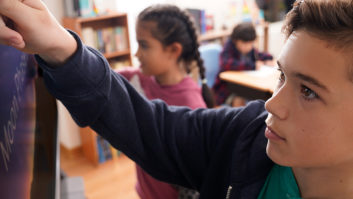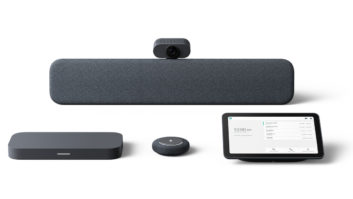 Just like the world of work, education has recently transformed from a strictly on-site activity to an entirely blended, hybrid experience. Today, students need to be able to connect to their lessons both in the classroom and remotely, during and after class.
Just like the world of work, education has recently transformed from a strictly on-site activity to an entirely blended, hybrid experience. Today, students need to be able to connect to their lessons both in the classroom and remotely, during and after class.
This rapid evolution means some institutions are still a little behind when it comes to equipping their learning spaces with the tools and technologies that modern students now demand. How can educators keep up with today’s cutting-edge trends and expectations, while still creating spaces that offer outstanding learning experiences now and long into the future?
EDUCATION TRENDS
The first major step is to look at what’s currently trending in higher education:
• Accessibility from everywhere, anywhere, all at once
Higher education’s focus must currently be on accessibility. Campuses need to have an agile and accommodating approach to the student population, as the ability to stream, broadcast, and capture teaching sessions is critical for student success and different learning styles. Students’ ability to connect in the classroom or remotely during or after a class is also vital to their success. Flexibility, autonomy of use (any platform should be accessible), the experience of the user, student device use and connectivity to an installed solution should all be priorities as education grows increasingly hybrid.
• Making artificial intelligence and augmented reality a reality
Remote lessons enabled by cameras and microphones were the biggest change to education in recent years. Moving forward, augmented reality can be expected to become the next big shift, and these types of technological advances are already seeping into the campus landscapes. While class spaces may not be equipping them as quickly as students are bringing the need to the campus, it is an inevitable move. Soon, these technologies will form an expected part of the learning experience.
Many educators are already using the AI, VR and metaverse collective in their teaching modalities where it fits the curriculum or teaching style. The ability to meet students where they arrive is the natural evolution. It is the students who will drive the speed of adoption. We are already using it in some platforms to create different views for the users. This will continue to develop to provide an experience that is more conducive to each individual learner.
AR doesn’t offer a ‘one-size-fits-all’ experience; however, the technology needs to appear that way for ease of use and the capability to easily transmit curriculum. As students grow accustomed to creating their own virtual environments and interfaces outside of the classroom, the ability and flexibility to create an experience tailored to everyone will become the expectation.
Some students might hope that they’ll no longer need to memorise or work on maths equations, for instance, if tools like AI are available. For those students, I have some bad news! Understanding concepts, such as mental arithmetic, will still be necessary – but fortunately, the process may not be as mentally taxing as maths becomes more and more automated.
Just as in the past software took the place of accounting, order processing, and architectural planning, tools for creating and processing will become more intelligent in this way. Goals and creativity will still begin at the human level, but new technologies may provide a different way and timeline to achieve the desired result.
FUTURE DESIGNS
To future-proof learning spaces, I’d prioritise the creation of highly flexible areas that provide for everything from rudimentary to extraordinary use cases. In other words, traditional lecture-style rooms that can seamlessly transition into more sophisticated spaces.
 The rooms’ enhanced systems should offer augmented video, enriched audio, and comfortable seating/furniture options that provide inclusive events and immersive sessions for the learner to experience sense-based learning options. Gaming and e-sports already provide these types of experiences with curved monitors, headphones and mics, and furniture that cocoons the person, making them one with the session. These environments will become more prevalent in classrooms to facilitate more immersive education.
The rooms’ enhanced systems should offer augmented video, enriched audio, and comfortable seating/furniture options that provide inclusive events and immersive sessions for the learner to experience sense-based learning options. Gaming and e-sports already provide these types of experiences with curved monitors, headphones and mics, and furniture that cocoons the person, making them one with the session. These environments will become more prevalent in classrooms to facilitate more immersive education.
However, the installation of all this advanced technology is meaningless if it’s then too complicated for everyday teachers to use. Systems still need to remain simple, functional, and appropriate for the type of class experience. As faculty members rely heavily on the technological components of a classroom to share curriculum, it needs to remain basic to facilitate to subject matter, rather than become the focus/issue of a session.
Training faculty to use the systems, standardising the user experience, and offering tools for help/assistance are all great starting points for a better experience for both teachers and students, and will ensure less disruption to teaching time. Plus, when a teacher knows what to expect and is comfortable and familiar with the system, they will use it more regularly and take advantage of its features.
When support and helpdesk create efficient processes and procedures, there is less downtime in classrooms and more faculty satisfaction. Setting up maintenance practices, hiring knowledgeable tech staff, and offering reliable solutions can make the difference. The reality is that solid campus technology, less down-time, and well-placed solutions, features, and functionality all help to facilitate greater student enrollment and retention.
Modern higher education (HE) has moved towards visual aids, interoperability and interactivity. And with the seamless technology now readily available to enable this, HE institutions must begin leveraging it to break down barriers to progress the industry alongside students and lecturers.







